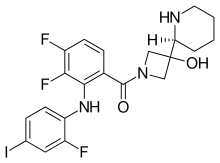Cobimetinib
Cobimetinib (trade name Cotellic) is a MEK inhibitor developed by Exelixis and Genentech (Roche). It is used in combination with vemurafenib, a BRAF inhibitor, to treat melanoma. In November 2015, the U.S. Food and Drug Administration approved cobimetinib for unresectable or metastatic melanoma with a BRAF V600E or V600K mutation, in combination with vemurafenib (Zelboraf). Cobimetinib is not indicated for treatment of patients with wild-type BRAF melanoma.[4]
 | |
| Clinical data | |
|---|---|
| Pronunciation | /ˌkoʊbɪˈmɛtɪnɪb/ KOH-bim-ET-i-nib |
| Trade names | Cotellic |
| Other names | GDC-0973, XL-518 |
| AHFS/Drugs.com | Monograph |
| MedlinePlus | a615057 |
| License data |
|
| Pregnancy category |
|
| Routes of administration | By mouth (tablets)[1] |
| ATC code | |
| Legal status | |
| Legal status | |
| Pharmacokinetic data | |
| Bioavailability | reported from 28%[2] to 46%[1] |
| Protein binding | 95%[1] |
| Metabolism | Intestinal and low hepatic clearance (mostly CYP3A4 oxidation and UGT2B7 glucuronidation)[1][2] |
| Elimination half-life | 44 hours (mean)[1] |
| Excretion | Feces (76–77%), urine (17.9–18%) (after oral and IV administration)[1][3] |
| Identifiers | |
| |
| CAS Number | |
| PubChem CID | |
| IUPHAR/BPS | |
| DrugBank | |
| ChemSpider | |
| UNII | |
| KEGG | |
| ChEBI | |
| ChEMBL | |
| CompTox Dashboard (EPA) | |
| Chemical and physical data | |
| Formula | C21H21F3IN3O2 |
| Molar mass | 531.318 g·mol−1 |
| 3D model (JSmol) | |
| |
| |
Cobimetinib in combination with vemurafenib is priced at $17,600 per month, or about $211,000 per year.[5]
Medical use
Cobimetinib is approved for use in combination with vemurafenib (Zelboraf) for the treatment of advanced melanoma with BRAF mutation (either V600E or V600K) that cannot be removed by surgery or which has metastasized.[1][6]
Adverse effects
Common adverse effects observed in cobimetinib and vemurafenib co-treated persons in clinical trials included diarrhea, nausea, vomiting, rash, photosensitivity, and pyrexia.[7]
History
Cobimetinib was awarded orphan drug status by the FDA for malignant melanoma with BRAFV600 mutation in 2014.
Acquired resistance to BRAF inhibitors, such as vemurafenib and dabrafenib, commonly occurs after several months of progression-free tumor response. Preclinical data indicated the involvement of MAPK pathways and MAPK-independent signaling in the developed resistance, suggesting dual inhibition of MEK and BRAF kinase as a strategy for increasing the longevity of tumor response seen with BRAF inhibition alone.
In phase III clinical trials, the combination of cobimetinib and vemurafenib was tested in patients with BRAFV600-mutated metastatic melanoma, which resulted in significant improvement in progression-free survival in patients, but also produced some increase in toxicity. The combination increased progression-free survival to an average of 12.3 months, compared to 7.2 months for vemurafenib alone. This clinical data also showed that the combination treatment resulted in 65% survival rate of patients 17 months after beginning the treatment, increased rates from the 50% of patients on vemurafenib treatment alone. Adding cobimetinib also increased the median overall survival to 25.6 months, compared to the 18 months for vemurafenib alone.[5][7]
Pre-clinical investigation suggests that combined use of Cobimetinib with PI3K inhibition could boost the anti-cancer effects of the drug, with a synergistic response being observed in lung cancer cell lines.[8][9]
References
- "Cotellic (cobimetinib) Tablets, for Oral Use. Full Prescribing Information" (PDF). Genentech USA, Inc., a Member of the Roche Group. 1 DNA Way, South San Francisco, CA 94080-4990. Retrieved 5 October 2016.
- Takahashi RH, Choo EF, Ma S, Wong S, Halladay J, Deng Y, et al. (January 2016). "Absorption, Metabolism, Excretion, and the Contribution of Intestinal Metabolism to the Oral Disposition of [14C]Cobimetinib, a MEK Inhibitor, in Humans". Drug Metabolism and Disposition. 44 (1): 28–39. doi:10.1124/dmd.115.066282. PMID 26451002.
- Choo E, Takahashi R, Rooney I, Gates M, Deng A, Musib L (January 30, 2014). "Abstract B160: Assessing Human Absorption, Metabolism, Routes of Excretion and the Contribution of Intestinal Metabolism to the Oral Clearance of Cobimetinib, a MEK Inhibitor". Molecular Cancer Therapeutics. 12 (11 Supplement): B160. doi:10.1158/1535-7163.TARG-13-B160.
- "Approved Drugs: Cobimetinib". U.S. Food and Drug Administration. Archived from the original on 2015-11-17. Retrieved 2015-11-16.
- Staton T (11 November 2015). "Ready to rumble, Novartis? Roche targets melanoma-fighting combo market with new FDA nod". FiercePharma. FierceMarkets. Questex. Retrieved 2 December 2015.
- "FDA approves Cotellic as part of combination treatment for advanced melanoma". U.S. Food and Drug Administration. 10 November 2015. Retrieved 2 December 2015.
- Larkin J, Ascierto PA, Dréno B, Atkinson V, Liszkay G, Maio M, et al. (November 2014). "Combined vemurafenib and cobimetinib in BRAF-mutated melanoma" (PDF). The New England Journal of Medicine. 371 (20): 1867–76. doi:10.1056/NEJMoa1408868. PMID 25265494.
- Heavey, Susan; Cuffe, Sinead; Finn, Stephen; Young, Vincent; Ryan, Ronan; Nicholson, Siobhan; Leonard, Niamh; McVeigh, Niall; Barr, Martin; O'Byrne, Kenneth; Gately, Kathy (2016-11-29). "In pursuit of synergy: An investigation of the PI3K/mTOR/MEK co-targeted inhibition strategy in NSCLC". Oncotarget. 7 (48): 79526–79543. doi:10.18632/oncotarget.12755. ISSN 1949-2553. PMC 5346733. PMID 27765909.
- Heavey, Susan; O'Byrne, Kenneth J.; Gately, Kathy (April 2014). "Strategies for co-targeting the PI3K/AKT/mTOR pathway in NSCLC". Cancer Treatment Reviews. 40 (3): 445–456. doi:10.1016/j.ctrv.2013.08.006. ISSN 1532-1967. PMID 24055012.